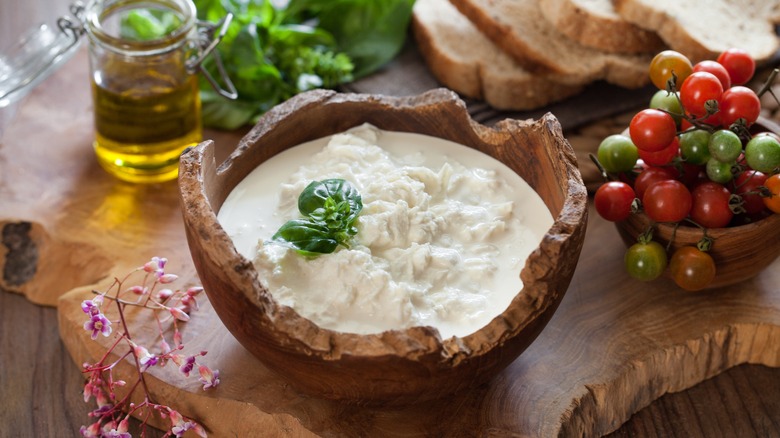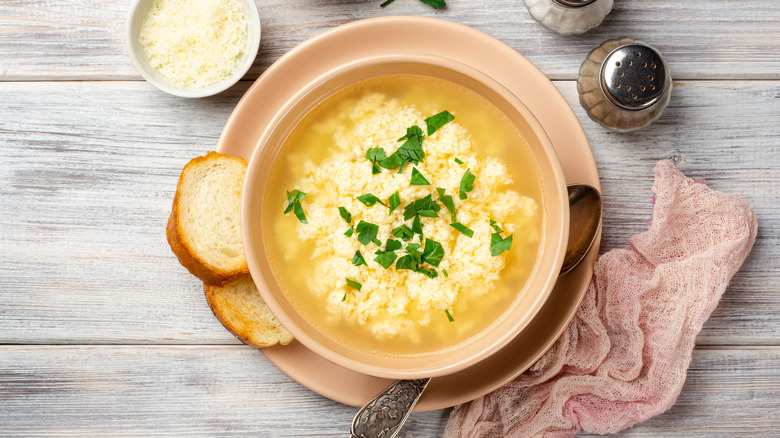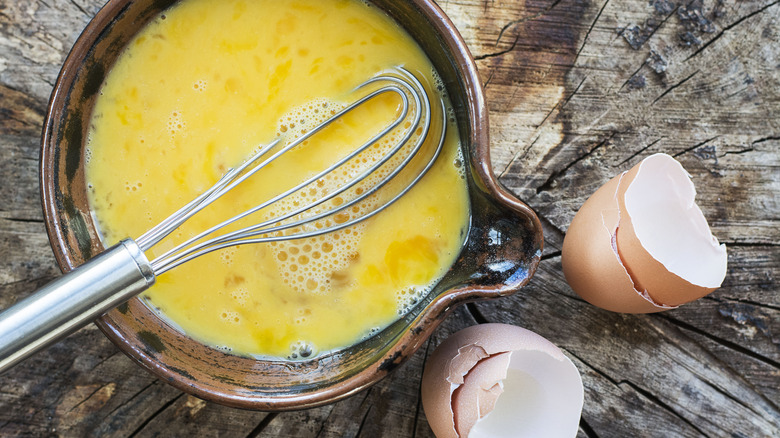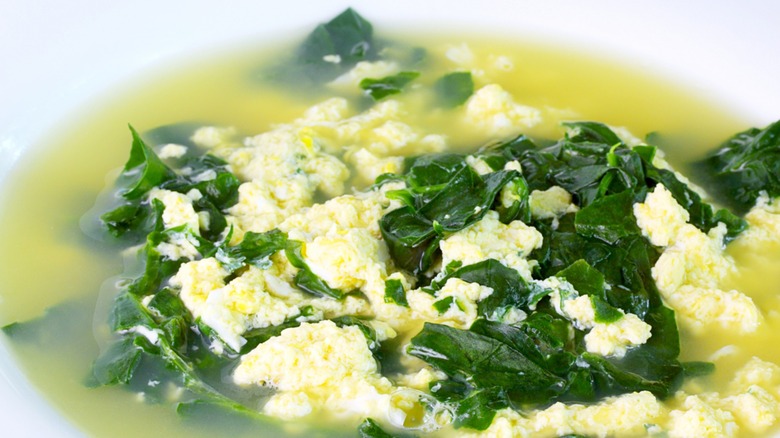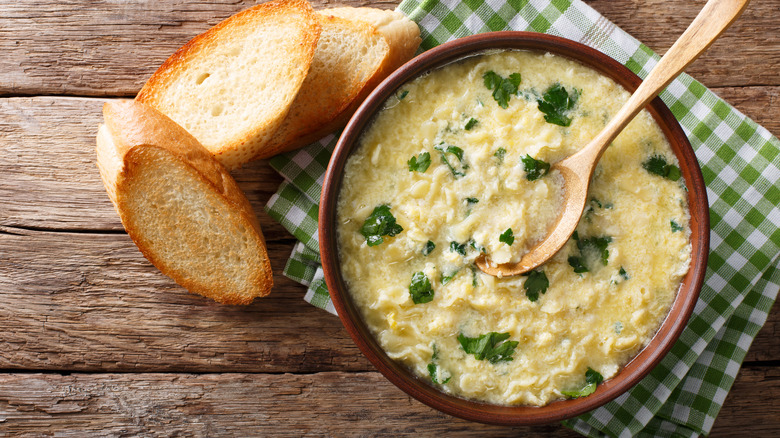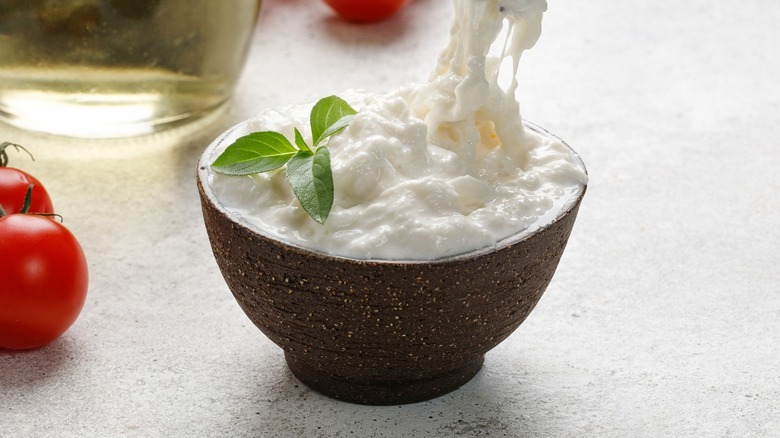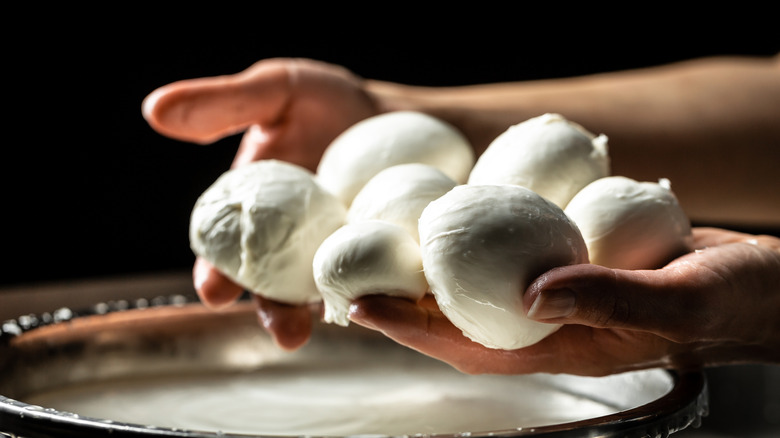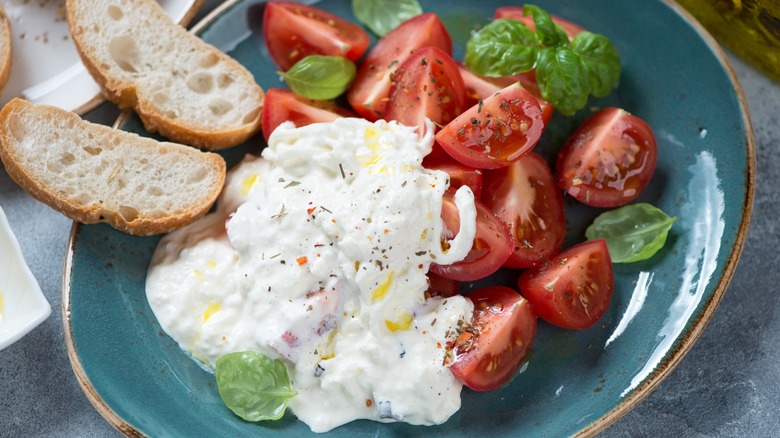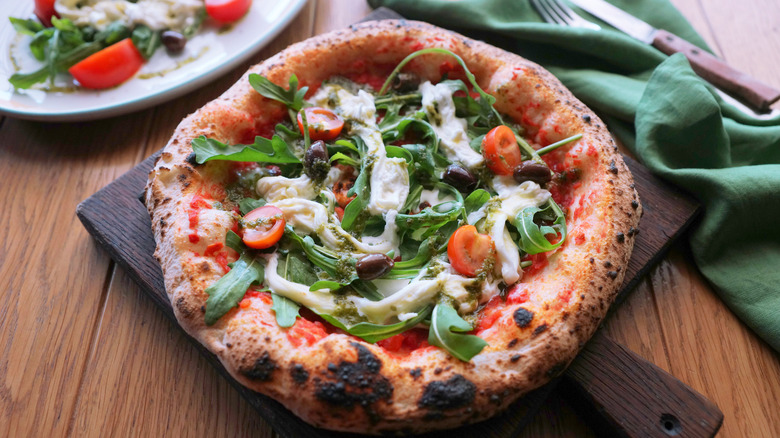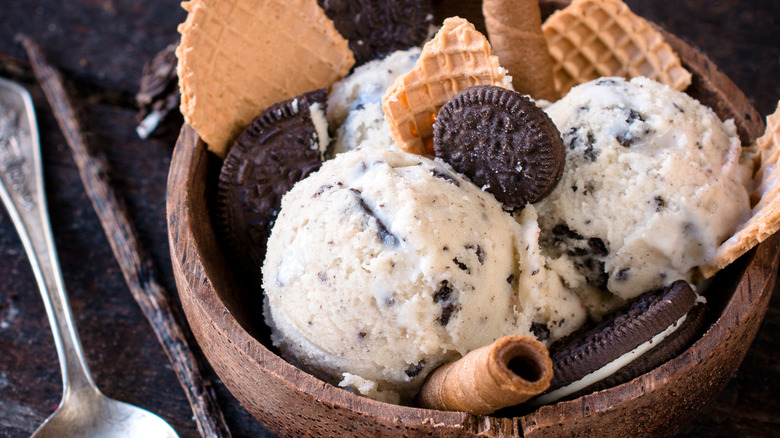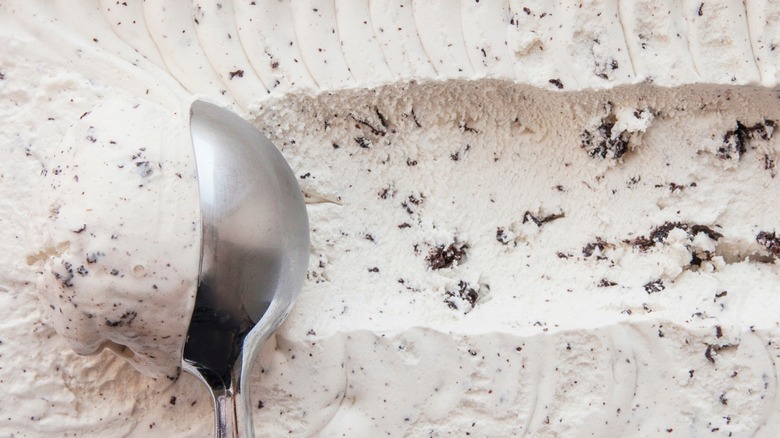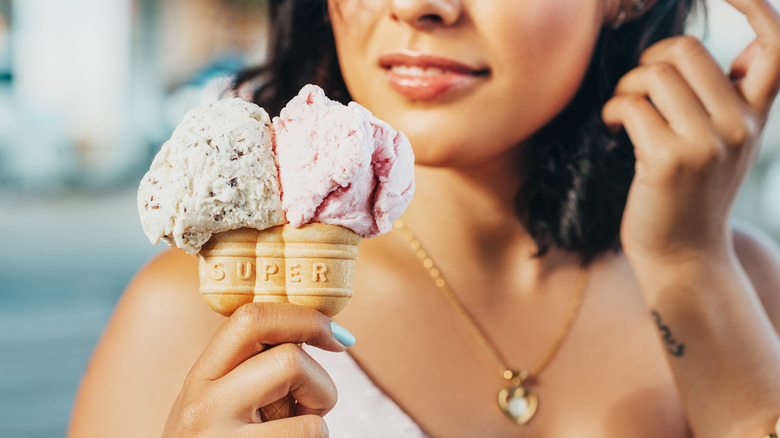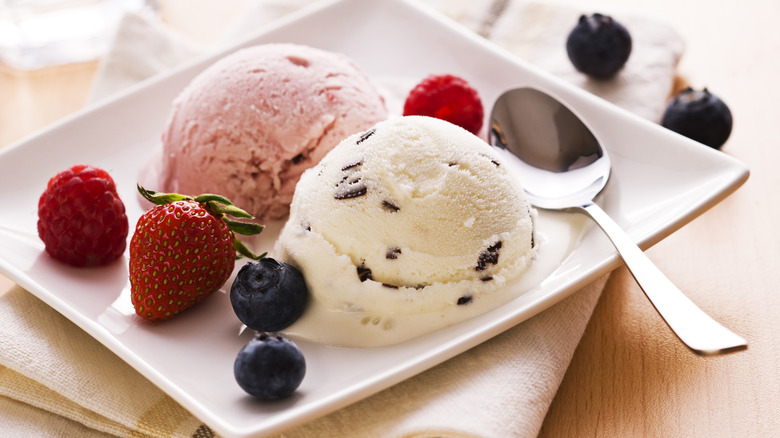What Is Stracciatella And Is It Really 3 Different Foods?
Ask three different people what stracciatella is, and you might get three different answers. But that's okay because this tongue-twister of a word really is the name of three different — yet equally delicious — Italian foods. When you place an order for stracciatella, you might be served a savory soup, a rich and creamy cheese, or a silky-smooth gelato. Yes, the same word is used to name three seemingly very different things. But why are there so many different forms of stracciatella?
The one thing all of these foods have in common is a certain textural quality for which they are named. The word stracciatella (pronounced stra-chuh-teh-luh) means "little rags" in Italian. Additionally, stracciatella is derived from the Italian word "stracciare," which means "to rip or tear." In their own ways, the soup, the cheese, and the gelato have a torn texture and appearance. This appearance comes from the processes by which they are made.
What is stracciatella soup?
Egg drop soup, most commonly known in its Chinese version, is a staple dish in many cultures. Stracciatella, in one of its forms, refers to a type of Italian egg drop soup. While a similar Italian soup called zanzarelli dates originated around the 15th century, stracciatella soup is said to have been developed during the 19th century. According to tradition, thrifty cooks used leftovers from Christmas meals to make a hearty broth that they thickened with eggs and other ingredients at hand.
Flavorful and filling, stracciatella soup quickly spread from Rome across the country, where it took on regional variations. Over generations, it spread even further as immigrants brought this comforting taste of home to new lands. Today, it remains a familiar item during holiday feasts during Easter or Christmas, where it is often served as the first course, or made with leftovers. Due to its quick and easy preparation with ingredients that are usually on hand, it can be served whenever a quick, nourishing meal is wanted, or when you need a cozy dish to warm up on cold evenings.
How is stracciatella soup made?
Stracciatella soup's popularity comes not just from its flavor, but also from its ease of preparation and versatility. Only three simple ingredients make up the basic recipe: clear broth (usually chicken), whole eggs, and Parmesan cheese. The eggs and cheese are whisked together and then drizzled or poured through a fork into a pot of simmering broth. Constant stirring as the egg mixture cooks in the broth produces the characteristic shredded appearance. While there are similarities to Chinese egg drop soup in the way it's made, the two versions have different flavor profiles. Italian stracciatella tastes more like a traditional chicken soup, while Chinese egg drop soup is flavored with things like soy and ginger.
The basic soup is often given even more flavorful heartiness with the addition of ingredients like spinach, pasta shapes like orzo or mini fusilli, herbs and spices such as nutmeg, parsley, lemon, and saffron, and thickeners including semolina or breadcrumbs. Adventurous cooks may stray further from the traditional base with additions like kale, shredded chicken, and even potatoes.
How nutritious is stracciatella soup?
Soups in general are considered healthy for several reasons. They help maintain hydration, are usually made with nutrient-rich ingredients like vegetables and lean meats, and may aid weight loss by providing a filling alternative to more calorie-intensive foods, per Healthline. Stracciatella soup is usually made with chicken broth, which — according to a 2000 study published in CHEST Journal – may have an anti-inflammatory effect that helps resolve illnesses like the common cold.
As uncomplicated as it is, stracciatella soup is both wholesome and nutritious. The eggs provide protein, vitamin D, and choline, which help improve your metabolism, liver function, bones, and immune system, reports the American Heart Association. Parmesan cheese, which is rich in calcium (via The Cheesemaker), contributes to the overall healthiness of this soup. The soup itself is also relatively low in calories. At around 300 calories per serving, that's just 15% of a woman's recommended daily calories and 12% of a man's daily calorie count, per the National Institutes of Health. Win! The dish can become even healthier if you choose to make your soup with bone broth. WebMD notes that bone broth is loaded with amino acids that can improve sleep, reduce inflammation, and aid in weight loss.
What should you serve with stracciatella soup?
As delicious as stracciatella soup is on its own, you'll probably want to serve other things with it. Side dishes are a great way to add balance to a meal, create more variety in flavors and textures, and augment nutritional value.
When served as the first course of a festive meal, stracciatella soup will set the stage for traditional feast favorites like roast lamb, lasagna, or manicotti. As the main course of a light meal, stracciatella soup may be accompanied by Caesar salad, garlic bread, or a grilled cheese sandwich. For a heartier side, consider twice-baked potatoes or steamed veggies like broccoli, cauliflower, and carrots.
Since stracciatella soup is very similar to Asian egg drop soup, you might include side dishes that are traditionally served with that version, such as beef and broccoli stir-fry, egg rolls, pot stickers, tofu, or fried rice. You may even wish to perform an Italian hat trick by serving stracciatella soup, stracciatella cheese, and stracciatella gelato!
What is stracciatella cheese?
The second type of stracciatella is a rich, creamy cheese. While the name might not sound familiar, you probably know it as the soft interior of burrata. Burrata means "buttered" in Italian, and that description applies best to the semi-liquid stracciatella filling inside the mozzarella pouch. Stracciatella cheese originated in the Italian region of Puglia around the turn of the 20th century. Puglia is known for its olive oil, pastas, and cheeses.
Legend has it that burrata, and thus stracciatella, were invented by a farmer named Lorenzo Bianchino, who was prevented by bad weather from bringing his fresh mozzarella and cream to market. Since at that time butter was sometimes wrapped in spun cheese to prolong its freshness, Lorenzo decided to adapt the technique, filling a pouch of mozzarella with sweet cream and the leftover bits of mozzarella.
While most commonly made from cow's milk, there is a regional variation of stracciatella cheese called stracciatella di bufala that is made with buffalo milk. Buffalo milk makes this variety of stracciatella slightly thicker and sweeter than the cow's milk version.
How is stracciatella cheese made?
Stracciatella cheese is made from fresh mozzarella curds that are soaked in water and then combined with sweat cream and other ingredients until most of the liquid has been absorbed, creating a rich, buttery, extremely soft cheese. It is this delightfully gooey substance that, when wrapped in a mozzarella shell, makes burrata.
With the increasing popularity of burrata, you probably will be able to find this cheese at a local grocery store or cheesemonger. If not, or if you want just the less commonly available stracciatella without the mozzarella shell, you can make it at home. For an expedited process of making this cheese, simply tear fresh mozzarella into pieces, then soak them in heavy cream. Sprinkle with a pinch of salt, cover, and let rest for an hour. What emerges will be something very similar to stracciatella cheese. It may not fool the purists, but is undeniably delicious!
How nutritious is stracciatella cheese?
This is a cheese that is literally sodden with heavy cream, so you won't be surprised to learn that, with 255 calories and 23 grams of fat per 100 grams of the stuff, it is not exactly a diet food. However, the fat in stracciatella comprises both saturated and unsaturated fats, with proportionately more of the healthier monounsaturated and polyunsaturated fats. These fats, according to Mayo Clinic, can reduce levels of bad cholesterol and lower the risk of heart disease.
You'll also find whey in stracciatella cheese, a complete protein that includes all essential amino acids. Whey can help you build muscle and stay satiated, among other potential benefits (per Healthline). Like most cheese, stracciatella is relatively high in sodium, with 500 milligrams per 100 grams or 22% of your daily recommended allowance. Excess sodium can be detrimental to health by increasing blood pressure, which can lead to heart attacks and strokes, according to the U.S. Food and Drug Administration. Since it is particularly rich in lactose, this cheese may also cause digestive upset in lactose-intolerant individuals.
On the other hand, stracciatella cheese also provides 260 milligrams of calcium, a beneficial nutrient. All in all, stracciatella cheese is a fairly wholesome indulgence that should be enjoyed with gusto — and in moderation.
How should you serve stracciatella cheese?
With its similarity to mozzarella, stracciatella cheese can be used in place of that cheese in many dishes. It's delicious dolloped on crostini and drizzled with a little olive oil, or topped with fresh, flavorsome ingredients like roasted red pepper, marinated artichokes, and sweet or savory jams. Create a delightful bruschetta by slathering stracciatella on toasted bread, then topping with thinly sliced tomato, fresh basil, and a splash of olive oil or prosciutto and pesto. Or simply place stracciatella in a shallow dish, drizzle with olive oil, sprinkle with sea salt, and serve with crusty bread.
Beyond appetizers, the creaminess of stracciatella cheese makes it ideal in pasta sauces, spooned over roasted veggies, or topping gnocchi alla Sorrentina or tomato risotto. Use it to dress a green salad or substitute it for mozzarella on your favorite homemade pizza. Basically, introduce stracciatella anywhere you'd use a mild, creamy cheese.
What is stracciatella gelato?
The final version of stracciatella is the newest, yet probably the most familiar to Americans. It is a smooth gelato with a vanilla base and chocolate pieces scattered throughout. These days you may find stracciatella gelato in ice cream shops and your grocer's freezer section. However, to discover the origins of this velvety delight, you have to go back to mid-20th century Italy.
It was created in 1962 in the Italian city of Bergamo. Enrico Panattoni, the chef at a bar called La Marianna in that city, was inspired by the appearance of the stracciatella soup to create a new gelato flavor, which he named stracciatella for the shreds of rich chocolate threaded through the ice cream. Panattoni, whose joy lay more in desserts than main dishes, once told a Bergamo newspaper that he created the stracciatella gelato because he was tired of making the soup version. In the decades since its invention, it has become one of the world's most popular frozen desserts.
How is stracciatella gelato made?
Although gelato means ice cream in Italian, this frozen confection is slightly different from what Americans think of as ice cream. It contains a higher ratio of milk to cream, incorporates less air, and is churned more slowly. These differences result in a silkier, denser texture. While some insist that true gelato contains only milk, cream, and sugar, eggs or egg yolks are sometimes used. The La Marianna website lists egg yolks among the ingredients currently used in creating the original stracciatella gelato, but it is not clear whether its inventor included eggs in his recipe.
To create the characteristics of chocolate streaks that give this flavor its name, a fine stream of melted chocolate is drizzled into the gelato mixture while it's churning. The chocolate hardens and shreds on impact with the cold mixture, infusing the finished product with bits of chocolate that are finer than most chocolate chip ice creams.
How nutritious is stracciatella gelato?
Since stracciatella, a type of gelato, is made with more milk and less cream than ice cream, it also has less fat and calories. That said, this is still a dessert, not a health food. Even with less cream, gelato is moderately high in fat and calories, with about 250 calories, 21 grams of sugar, and 16 grams of fat per 100 grams. According to the American Heart Association, men should limit daily sugar intake to 36 grams of sugar, and just 25 grams for women. The AHA recommends no more than 13 grams of fat per day. Like all rich, sweet confections, stracciatella gelato is a treat best enjoyed occasionally.
However, stracciatella gelato also contains protein and calcium. It can also be made with dark chocolate, which a 2011 study published in Antioxidants & Redox Signaling found may offer anti-inflammatory benefits, lower your blood pressure, and even improve your vision. Dark chocolate also contains helpful minerals, including magnesium, zinc, iron, phosphorus, and copper (per WebMD).
How should you enjoy stracciatella gelato?
There are some special considerations for serving and enjoying stracciatella gelato that differ from regular ice cream. For the most authentic experience, gelato should be served at a slightly higher temperature than ice cream. While ice cream is served at around 10 degrees, gelato should be scooped at up to 22 degrees Fahrenheit. This is because gelato's density makes it freeze harder.
To avoid ice crystals forming in your stracciatella gelato, it's best to avoid exposing it to wide temperature changes. Ice cream shops serve fresh-made gelato in small batches out of special gelato freezers set at a higher temperature to keep the dessert scoopable. For most of us, though, storing it at the back of the regular freezer in an airtight container will keep it in top shape for as long as it takes to consume it ― which isn't usually very long! Master gelato artisans recommend consuming gelato within a few days of its creation for optimum freshness and the smoothest texture, and suggest storing stracciatella gelato in smaller pint containers rather than larger tubs.
As for other gelato flavors to pair stracciatella with, dark chocolate, raspberry, mint, or strawberry gelato flavors pair well with the treat. You may choose to add some additional toppings, like fudge or caramel sauce, chopped nuts, sliced maraschino cherries, and whipped cream.
